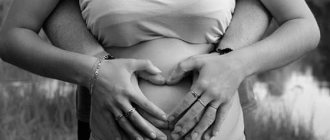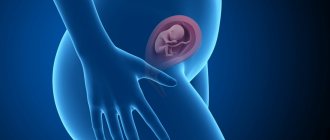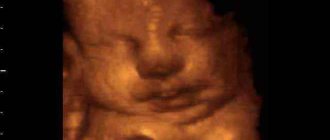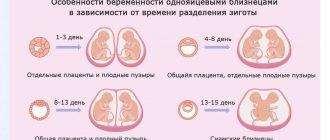This week the baby looks just like a miniature newborn baby. His height is approximately 27.5 cm, and all - 350-420 g. The child’s skin is still wrinkled and will remain so until the amount of subcutaneous fat becomes sufficient. The fluff that covers his entire body became visible. The lips are clearly visible, the eyes are almost fully developed, only the iris still lacks the pigment that gives it color. The pancreas, which produces hormones, also develops further. The fetal head is still quite large, but the face is already well formed. Eyebrows formed last week, and at week 22 eyelashes appear on the upper and lower eyelids, the fetal eyes open and close. The outlines of the nose become clearer, are finally formed and the ears increase in size. In addition to vellus hair, the baby's body is covered with a cheese-like lubricant.
All organs and systems of the baby are differentiated; at week 22 they already perform their specific functions. The fetal liver is already producing enzymes that are necessary for the normal functioning of the body, but still in small quantities. The main function of the liver of an unborn child is to process toxic bilirubin into harmless (or, as it is sometimes called, indirect - into direct). Toxic bilirubin is formed during the breakdown of hemoglobin, which is contained in red blood cells. Due to the fact that blood cells in the fetus are destroyed much faster than in humans, much more indirect bilirubin is formed in the fetus. This bilirubin in the blood enters the liver, where enzymes act on it, turning it harmless. After “processing,” bilirubin is excreted from the body into the placenta, and from there into the maternal blood. Before the moment of birth, the child’s liver must move from the exchange of bilirubin in the mother’s body to the exchange in its own body. If a baby is born premature, there is a good chance that the liver has not yet fully developed and levels of toxic bilirubin will be elevated. In this case, we speak of physiological jaundice of newborns, which is manifested by a yellowish tint to the skin and whites of the eyes. Jaundice is treated by phototherapy, light rays penetrate the baby's blood and destroy indirect bilirubin.
What happens at 22 weeks of pregnancy
At week 22, active fetal growth is observed. His body becomes more and more complex, more and more of its systems are improved and begin to function, and the brain develops.
As for the woman’s body, it is not yet experiencing very large stresses preceding childbirth, so she feels quite good. The twenty-second week of pregnancy is a good time for enjoyable activities. It’s worth reading your favorite book, watching a good movie, meeting with close friends and family.
It is also necessary to visit your doctor during this period of time. During the appointment, the specialist will measure the abdominal circumference, determine the weight of the expectant mother, and give recommendations on nutrition and behavior for the coming weeks.
At 22 weeks of pregnancy, a woman may face some dangers. They are associated primarily with incorrect location of the fetus or placenta.
Signs such as sharp pain in the lower abdomen, general deterioration in health, and spotting may indicate a low location of the placenta . Low placentation at 22 weeks of pregnancy is often diagnosed in women giving birth for the second time or more. If it is present, daily rest and lack of physical stress on the body is recommended.
What's happening
The 21st week of pregnancy is a kind of milestone, and from the end of this period the child will be able to live outside the mother’s womb. The internal organs of the fetus are fully formed, and now the process of their functioning is improving.
Your baby's skin has become tight, smooth and pink. Muscle and bone tissue grow and strengthen. At 21 weeks of pregnancy, the baby constantly swallows amniotic fluid, training its lungs and esophagus. The endocrine system is already working, and at this stage the spleen joins it.
The active development of the brain continues: the cortex is formed, new convolutions and grooves appear, and nerve cells divide. At the 21st week of pregnancy, fetal movements become more coordinated.
In a sufficient amount of amniotic fluid, the baby freely changes position: it turns upside down, then upside down, and spins around its axis. During the day, movements alternate with periods of deep sleep. Monitor the movements of the baby during waking hours: the 20th - 21st week of pregnancy is the period when excessive activity can be a sign of a lack of oxygen, in addition, it happens that in later stages sharp chaotic movements lead to the fetus being entangled in the umbilical cord. Therefore, be sure to tell your doctor about this.
Fetal development at the twenty-second week of pregnancy
The unborn child at this stage of its development reaches an impressive weight - approximately 450 g. Particularly large babies weigh already 500 g during this period. The size of the fetus at the 22nd week of pregnancy is about 28 cm. It is already quite well developed and adapted to life.
It is believed that starting from this time, the child can, with certain care, survive outside the mother's body. However, children born prematurely at 6 months are usually born very weak, low in weight and require a lot of attention from specialists.
A special difference between a 6-month-old fetus is its already formed brain, which weighs about 100 g. The development of the central nervous system affects the child’s behavior. He already unconsciously turns his head, can distinguish sounds and, according to some sources, even tastes. It has been established that the taste of amniotic fluid is affected by a woman’s daily diet.
The body of the fetus at this stage of development is covered with thin short hairs, which by the time of birth will disappear, giving way to full-fledged vegetation characteristic of the human body.
Week 22 Your baby is the size of a zucchini
Indicators and norms for ultrasound of the 22nd week
The basic norms for a planned ultrasound at the 22nd week coincide with the ultrasound at the 20th week (second screening). Although in some points the decoding is noticeably different - the baby is growing so quickly that its size and volume change every week of pregnancy.
Decoding the ultrasound results of the 22nd week includes the following parameters:
- The baby's height is approximately 27.8 cm, weight is about 430 g;
- The fronto-occipital size of the child's head (FZR) is 64-76 mm, biparietal size (BPR) is 48-60;
- Abdominal circumference – 148-190, head circumference – 178-212 mm;
- Baby bone lengths: lower leg – 31-39 mm, thigh – 35-43 mm, forearm – 26-34, shoulder – 31-39;
- The weight of the brain is about 100 g, the size of the cerebral ventricles is 10 mm;
- The thickness of the patient’s placenta is 18.1-30.7 mm, the degree of maturity is zero;
- The volume of amniotic fluid is 89-235 ml;
- The length of the cervix is about 3 cm (more than 2.5 cm);
- The number of vessels in the umbilical cord is 3 (two arteries and one vein).
Feelings of the expectant mother
A woman at 22 weeks of pregnancy may be bothered by various symptoms due to the peculiarities of her position. One of the main symptoms is aching pain in the lower back and back. This pain occurs due to excessive stress on the spine. It will usually intensify before childbirth and disappear completely after the baby is born.
Special gymnastics and alternating wakefulness and rest relieve pain well. During this period, expectant mothers are recommended to attend special classes for pregnant women, where they will be taught how to breathe correctly and quickly relax after the fatigue of the day.
The troubles of the 22nd week of pregnancy include hemorrhoids. This problem is becoming a frequent companion of expectant mothers. With hemorrhoids, pain in the anus, difficulty in bowel movements, and bleeding from the rectum may occur.
There are no signs of toxicosis at this time. If you feel sick at 22 weeks of pregnancy, you should consult a specialist, not only a gynecologist, but also an endocrinologist or an infectious disease specialist. Nausea may also indicate poisoning.
Rarely, nausea is caused by excessive activity of the fetus, when this activity causes stomach irritation.
With such a phenomenon as the transverse position of the fetus at 22 weeks, a woman often has an irregular shape of the abdomen. Physically it is not felt at all. In the transverse position, the unborn child is located in the uterus in such a way that its spine is at right angles to the mother’s spine. This condition is diagnosed by ultrasound. If it is present, expectant mothers are prescribed special gymnastic exercises. If the anomaly persists until delivery, a cesarean section is performed.
Recommendations
- If you experience shortness of breath at 21 weeks of pregnancy, start learning breathing techniques. Subsequently, they will be very useful during the birth process;
- Due to hormonal changes, the skin may become covered with pigment spots. To get rid of them, try wiping such areas with lemon juice or milk;
- If you are worried about heartburn, try not to eat before bed, because in a horizontal position, gastric juice rises to the throat and burns the mucous membrane. During heartburn attacks, you can take a knee-elbow position for a few minutes;
- Constipation is one of the most common problems faced by women in the 20th – 21st week of pregnancy. In order to cope with it, you need to reconsider your diet. Eat more fermented milk products (but don’t go heavy on cottage cheese and hard cheeses), enrich your diet with sources of fiber (vegetables, fruits, bran bread), start the day with a glass of water.
Movement in the lower abdomen at 22 weeks of pregnancy
During this period of time, the unborn baby behaves very actively. He makes quite complex movements; his sharp jolts can wake up his mother even at night.
Often the rhythm of the fetus’s life does not coincide with the rhythm of the woman’s life, so she feels its movements at night. The child's quiet, calm behavior indicates that he is at rest, dozing or sleeping. It shouldn't be a cause for concern.
At week 22, expectant mothers usually regularly feel tremors from within. This can be both a reason for joy and a reason for deterioration in well-being.
Fetal movement in the lower abdomen at 6 months is normal. The child's behavior is often determined by his feelings inside the uterus and even his future character. All movements are carried out unconsciously. However, children are known to act more violently when they don't like something. For example, a sharp sound or the psychological mood of the mother.
Stomach
The belly at the 22nd week of pregnancy continues to grow, but its increase does not yet cause significant discomfort to the expectant mother. It is advisable at this time to purchase clothes for a pregnant woman, in particular, underwear, pants, and loose blouses.
In no case should things put pressure on the stomach, pelvis, chest, or interfere with bending, sitting, or doing other work. At week 22, it is important to pay attention to caring for the skin of the abdomen. Rapid growth leads to itchy skin, stretching of tissues and the appearance of stretch marks, which are difficult to get rid of after childbirth. For prevention, you should moisturize your skin daily.
How is ultrasound performed?
Depending on the purpose of the examination, specialists from St. Petersburg State Budgetary Healthcare Institution “Women's Consultation No. 22” conduct ultrasound in two ways:
- transabdominal - the study is performed with a special sensor through the abdominal wall;
- transvaginal - the most informative method in which the sensor is inserted into the vagina. It allows you to examine the pelvic organs in detail and make a reliable assessment of their condition.
All ultrasound examination methods are absolutely safe for the patient and do not cause discomfort.
To make an appointment for an ultrasound scan or get detailed information about services and opportunities, you can call: 296-32-10, 8-951-650-48-57, 296-32-43
Please: if you have data from previous ultrasound diagnostic studies, take them with you.
Beauty and accessories
Can I use deodorants and antiperspirants during pregnancy? Doctors recommend that women use natural deodorants - they do not contain alcohol, fragrances, aluminum salts or chemical additives, and therefore are absolutely harmless. Alum stone or alunite will also help get rid of unpleasant odors. This safe natural deodorant mineral blocks the activity of various microorganisms without leaving any traces on the body, while the sweat glands continue to work as before. As for antiperspirants, doctors do not allow treating areas of the skin with them during an “interesting situation” - they narrow the sweat ducts, thereby undermining the functioning of the kidneys and provoking the development of a variety of ailments and unpleasant sensations in pregnant women.
Good to know
How does weight change during pregnancy?
Singing before birth. About methods of musical improvement of the unborn child
How a pregnant woman can cope with stress at work
Ten phrases that irritate pregnant women
Heartburn during pregnancy: how to get rid of it? 4 ways to prevent heartburn
How to treat hemorrhoids in pregnant women
Medicines for hemorrhoids during pregnancy
Why do you crave salty foods during pregnancy?
Professor I. Kon about healthy eating during pregnancy
All texts for pages about mother and baby were kindly provided by RAMA Publishing - these are chapters from the book by Svetlana Klaas “Your Favorite Little Man from Conception to Birth”, reviewer Irina Nikolaevna Kononova, Candidate of Medical Sciences, Associate Professor of the Department of Obstetrics and Gynecology of the Ural State Medical Academy (Ekaterinburg).
Tests and studies during pregnancy
Visiting a doctor monitoring pregnancy: once a month.
Weighing, measuring blood pressure, measuring the height of the uterine fundus, listening to the fetal heartbeat. General urine test - before each visit to the doctor. Indicates the quality of kidney function.
Visiting specialists: therapist, ophthalmologist, otolaryngologist, dentist.
ECG (electrocardiogram).
Hormone analysis - according to indications .








